MEET TRUFFLES
This pet pig lives ‘in the lap of luxury’.


MEET TRUFFLES
This pet pig lives ‘in the lap of luxury’.


For more than 100 years, the Commerce Trust team of experienced wealth specialists has helped both individuals and institutions uncover opportunity amid increasing complexity and achieve their long-term financial goals. Learn more about our team-based approach at commercetrustcompany.com.






MANAGEMENT
Erica Pefferman, President Erica@comocompanies.com
David Nivens David@comocompanies.com
EDITORIAL
Publisher | Erica Pefferman Erica@comocompanies.com
Editor | Jodie Jackson Jr Jodie@comocompanies.com
DESIGN
Creative Director | Kate Morrow Kate@comocompanies.com
Senior Designer | Jordan Watts Jordan@comocompanies.com
Photo Editor | Madi Green Madi@comocompanies.com
MARKETING
Director of Account Management Keeley Duncan Keeley@comocompanies.com
Director of Web Services J. J. Carlson JJ@comocompanies.com
Marketing Representative Sarah Hempelmann Shempelmann@comocompanies.com
Marketing Representative Becky Roberts Becky@comocompanies.com
CONTRIBUTING PHOTOGRAPHER
Anthony Jinson, Madi Green

Sara Nivens Sara@comocompanies.com
MARKETING
Director of Sales | Charles Bruce Charles@comocompanies.com
OUR MISSION
To inspire, educate, and entertain the citizens of Columbia with quality, relevant content that reflects Columbia’s business environment, lifestyle, and community spirit.
CONTACT
The COMO Companies 404 Portland, Columbia, MO 65201 (573) 499-1830 | comomag.com @wearecomomag
SUBSCRIPTIONS
Magazines are $5.95 an issue. Subscription rate is $54 for 12 issues for one year or $89 for 24 issues for two years. Subscribe at comomag.com or by phone.
CONTRIBUTING WRITERS
Candice Ball, Alicia Belmore, Beth Bramstedt, Barbara Buffaloe, Lori Galaske, Andrew Grabau, Lydia Graves, Mary Kate Hafner, Hoss Koetting, Natasha Myrick, Erica Pefferman, Rhonda Stone Proctor, Marcus Wilkins, Kelsey Winkeljohn


Ihis is such a fun issue. Who doesn’t like animals? I mean, there are some of you that don’t like animals…but you’re also the same people who don’t like French fries and America. (I tease, I tease!)
Pets have always been a big part of my life and my children’s lives as they grew up. We always had puppies and kitties in the house and on the farm, and now as adults, they have carried on with having their own pets as part of their families. It is heartwarming to tell stories of our favorite pets from the past such as my cat Walter White who only would lay in the whites in the laundry room or was so chill that you could turn the water on in the sink he was laying in and wouldn’t move or my dog Ellie that would let the kids bury her in sand. It is adorable to watch my granddaughter crawl excitedly toward my sister’s dog Gri n when we visit (who is a giant Golden Retriever who is afraid of a tiny baby) or have my dog Rhodey take immediate possession of her when she comes to my house. She is his baby for sure.
Having pets in the family is a big responsibility. It has taught my kids to care for another living thing. It has taught them to think of the needs of another. It has taught them what it means to have a responsibility outside of yourself. It gave us opportunities to teach them about love and the circle of life. And now, as all my kids have left home, it has taught me that having pets around isn’t the same when you’re an empty nester. As my life has changed and the activity of my house has diminished greatly, I look at my two big doggos and just know that they aren’t getting the same attention they did when the place was swarming with kids. I have a lot of dog mom guilt about that.
I travel a lot and work long days. Dog sitting is expensive. I investigated doggie daycare. Holy cow!! at brought back PTSD from having a daycare bill that was higher than my mortgage. Truthfully, the story in this issue about rehoming your pets was




one that came from a conversation that I had with friends of mine who have found themselves in similar situations through life change for themselves or their parents. When it was brought up in our advisory board meeting, it was met with the most discussion of any other point we discussed. It’s a hard conversation to have and one no one wants to have out loud. Admitting you can no longer care for or want to care for a pet comes with embarrassment and shame. If you nd yourself needing support, please do turn to the resources provided in this issue. I am hopeful they can be helpful to you as they have me and so many others.
 ERICA PEFFERMAN PUBLISHER erica@comocompanies.com
ERICA PEFFERMAN PUBLISHER erica@comocompanies.com

We take pride in representing our community well and we couldn’t do what we do without our COMO Magazine advisory board. Thank You!





Beth Bramstedt
Church Life Pastor Christian Fellowship Church


Heather Brown
Strategic Partnership Officer Harry S Truman VA Hospital

Nickie Davis
Executive Director The District, Downtown CID

Sam Fleury
Assistant Vice President
Strategic Communications, Columbia College

Jeremiah Hunter
Assistant Police Chief
Commander Investigations Bureau Columbia Police Department
Chris Horn
Sr. Reinsurance Manager American Family Insurance

Kris Husted
Senior Content Editor NPR Midwest Newsroom
Amanda Jacobs Owner Jacobs Property Management
Megan Steen
Chief Operating Officer, Central Region Burrell Behavioral Health
Nathan Todd
Business Services Specialist First State Community Bank
Wende Wagner
Director of Resource Development
The Boys and Girls Club of the Columbia Area
Have a story idea, feedback, or a general inquiry? Email Jodie@comocompanies.com.


Photographer Brianna Thoenen offers free ‘rainbow sessions’ to provide comfort to pet owners.
BY CAROLINE DOHACKIt was a great day to be Bear. e sun was shining and her pack — owners Jessica and Charles Bruce; their 18-yearold son, Donovan; and their other dog, Moose — were right there with her, romping and running. It had been a while since Bear was able to romp and run.
Jessica Bruce remembers the day as bittersweet. Bear, a 12-year-old black Labrador, had been diagnosed with histiocytic sarcoma, an aggressive form of cancer, weeks earlier. e prognosis was grim. e veterinarian estimated Bear had about two months to live.
Brianna oenen also was there that day, snapping pictures as the family enjoyed their afternoon. As a portrait photographer, oenen’s bread and butter is senior pictures for graduating high school and college students, but she also does pet photography and o ers what’s called rainbow sessions — so called because animals often are said to “cross the rainbow bridge” when they pass away — to people whose furry family members are nearing the ends of their lives.
Having lost beloved dogs herself — Sage and Ebony, two Cocker Spaniels, — oenen understands the enormity of the grief that can follow. And that’s what inspired her to nd a way to o er solace to others.
oenen doesn’t charge for rainbow sessions, and she does her best to be available even when situations take a sudden turn for the worst. oenen says it’s not unusual for her to meet clients at their veterinarian’s clinic to document the nal moments before an emergency euthanasia.
Even in these heartbreaking moments, oenen believes there’s an opportunity to o er comfort. She hopes that by documenting small details — a grizzled beard, worn-down paw pads — she can help others work through their sorrow.
But other times, there’s space to plan for joy.



“Recently I got to go along for a ‘last best day’ eld trip,” oenen said. “It was pretty cool. We cried a whole bunch, I’m not going to lie, but we got to go to Starbucks to get pup cups and McDonald’s and got a hamburger and French fries. We went to their favorite spot at the park and people watched. It was a good day.”
Bear’s rainbow session was one of these eld trips. Jessica, who owns the nail salon Manic Cure, says she rst heard about oenen’s services from a client. She called right away and told oenen about Bear’s diagnosis, but she was initially hesitant to commit anything to the calendar.
oenen understands these can be emotionally fraught times for pet owners, but previous experience working as a nursing technician at Stewart Cancer Center at Boone Hospital has shown her that there can be moments of exuberance even in darkness.
“I witnessed two weddings while I was there,” oenen says. “ at’s a whole dif-
ferent world, but I feel like that’s where stories matter.”
Jessica adds, “We had the most beautiful day at Stephens Lake Park. I commented to Charles that it felt weird being so happy while doing something that had such sad undertones ... [Brianna] made the experience such a positive one. She was the perfect person to do that for us.”
Bear crossed the rainbow bridge exactly two weeks after the photo session. oenen heard about it from a mutual friend and immediately sent Bruce an email with the link to a gallery of edited photos along with a note saying to take her time and look when she’s ready.
“If there’s any kind of solace in those pictures, then I feel good,” oenen said. “Sometimes a client will reach out on their pet’s birthday or the anniversary of their passing and say the photos mean something. at means so much to me.”
ere's more online!







One of the many favorable things about our fair city is how pet friendly we are. ere are ample things to enjoy, and many places allow us to bring our favorite furry friends along for the fun. For starters, Columbia Parks and Recreation oversees over more than 3,700 acres of parkland, maintains seventy- ve parks, and over sixty miles of trail.
Open space, parks, and trails provide opportunities to enjoy the extensive natural beauty of Columbia.
We want to help you navigate some of these, pointing you in the right direction for all the fun as well as other needs such as dog washes and dog friendly patios. It’s all listed right here so you can get involved in all the pet-friendly locales.
While there are many dog parks — including some leash free areas — there are also many miles of trails to enjoy with your pups. (Just remember that there’s a leash law. Pups must be on a leash for the safety or others and your furry friend. If you’re not sure if the spot you go to is leash-free, assume it is not.)
Dog Park:
• Garth Nature Area (leash free area)
Dog Wash:
• Tractor Supply Co.
• Route B Car Wash
• Buchheit North
Dog-friendly patios:
• Sonic Drive-In
• D & D Pub and Grub
Dog Park:
• Grindstone Nature Area (leash free area)
Dog Wash:
• Treats Unleashed
• Green Meadows Car and Pet Wash
• Buchheit South
• Lizzi & Rocco’s
Dog-friendly patios:
• Como Smoke and Fire
• Deuce Pub & Pit
• Honey Baked Ham
• Dairy Queen
• Your Pie
• Park Restaurant & Bar
• McAlister’s Deli
• Pierpont General Store
• Pappo’s Pizzeria
• D. Rowe’s
• Jina Yoo’s Asian Bistro
Dog-friendly patios:
• Glenn’s Cafe
• Ozark Mountain Biscuit & Bar
• Beet Box
• Cafe Berlin
• Logboat Brewing Company
• McNally’s
• Range Free
• Broadway Diner
• Fuzzy’s Taco Shop
• Shiloh Bar & Grill
• Main Squeeze
• Billiards on Broadway
• Campus Bar & Grill
• Uprise Bakery
• El Oso Mexican Grill
• International Tap House
• Lakota Co ee
• Sake Japanese Bistro & Bar
• Mugs-Up Drive In
• Yogoluv: Frozen Yogurt & More
• Starbucks
• Noodles & Company
• Several spots in the North Village Arts District and the Arcade District.
Dog Park:
• Indian Hills Park
Dog-friendly patios:
• Stadium Grill
• Freddy's Frozen Custard & Steakburgers
• Culver’s
• Panera Bread
• Noodles & Company
• Bandana’s Bar-B-Q
• Starbucks
Dog Parks:
• Twin Lakes Recreation Area (large leash free area)
• Cosmo Park (designated o -leash area)
Dog Wash:
• Lizzi & Rocco’s
• Petco
Dog-friendly patios:
• Culver’s
• Jazz A Louisiana Kitchen
• Andy’s Frozen Custard
• First Watch
• Truman’s Bar & Grill
• Chick- l-A
• Shakespeare’s Pizza
• Just Je ’s
• Sports Zone
• Five Guys
• Rio Grande Mexican Restaurant











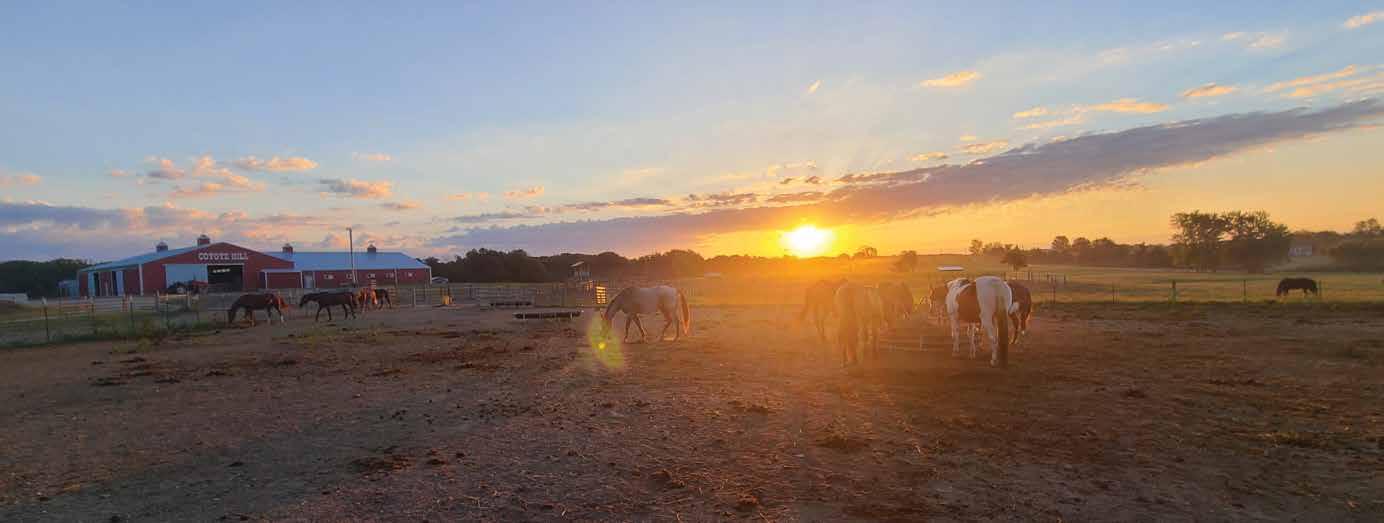

Healing takes the reins at Cedar Creek just south of Columbia. Since 1988, the team — led by Karen Grindler, a PATH-certied instructor, and Constance Crumpton, the occupational therapist — has been on a journey to better the lives of many with equine therapy. e center houses a sixty-acre ranch, where forest and winding trails o er the perfect backdrop for bodyand-soul soothing experiences. Operating with mostly donated horses, Cedar Creek ensures riders of all ages nd support, condence, and a smile in the saddle.
“ e movement of the horse is the closest thing you can get to the human walk. A horse is four-dimensional, up and down; side to side; diagonal, and forward and backward just like walking,” Grindler explained. “So for riders in wheelchairs or those with impediments to mobility, the simple act of riding strengthens large muscle groups ... Mentally it [provides] self-esteem and self-con dence that comes from riding a huge, magni cent animal. And for the riders with PTSD and emotional issues, it is the friend who is there for them week after week without judgments — just unconditional love.”

e visionary behind Coyote Hill Foster Care Ministries’ equine program, Larry McDaniel has a passion for both horses and healing. Over thirty-three years ago, Larry and his late wife, Cathy, embarked on a journey to create something remarkable in a kid-friendly rural area near Harrisburg, about twenty-two miles north of Columbia. McDaniel didn’t stop there; he saw an opportunity to harness the healing of equine therapy to make a di erence.
Fast forward twenty-three years, and Coyote Hill’s equine program has bloomed from humble beginnings to a sprawling fourteen-stall stable with indoor and outdoor arenas, trails weaving across three hundred acres, and a herd of twelve horses, three miniature horses, and one mule. (It’s a place where horsin’ around isn’t a gurative expression.)
From foster children to military veterans, McDaniel’s equine program has served as a sanctuary for those in need. rough therapeutic riding lessons, participants embark on a journey of self-discovery, building trust, empowerment, and emotional resilience. McDaniel’s passion for horses isn’t just about riding; it’s about creating a safe space and a step toward resilience and joy.

At Sunny Oak Farm, just thirteen miles west of Columbia on thirty- ve acres of rolling pasture near Rocheport, the small but mighty farm is a haven for horse lovers. From a bustling three-acre jump eld to the sand arena and cozy tack room, it houses all the tools for equestrian excellence.
Under the expert guidance of owner and trainer Rosy Erganian, Sunny Oak Farm isn’t just a place to ride; it’s a community where riders of all ages and abilities come together to learn, grow, and connect with four-legged friends. With Erganian’s wealth of experience, including stints at Cedar Creek erapeutic Riding Center and a lifelong love a air with horses, riders are certainly in good hands.
Sunny Oak believes in the power of the horse to transform lives. From adaptive riding lessons tailored to individual needs to a week-long summer day camp, packed with equine adventures, every experience is designed to foster physical, social, and emotional growth ... the horses foster and nurture unforgettable moments.
Whether you’re a seasoned equestrian or just getting started, there’s always room in their barn for one more.






As mayor, I have the privilege of representing our city in ways that extend well beyond our local boundaries. One of the most impactful ways has been through my active participation in associations and networks. is June, I and hundreds of mayors from around the country, will be gathering in Kansas City, Missouri for the annual meeting of the U.S. Conference of Mayors.
e U.S. Conference of Mayors is a nonpartisan association where mayors engage directly with the president and Congress on the most important issues facing cities today. Like any good organization, the U.S. Conference of Mayors is an engine of progress, fostering collaboration among members, helping members share best practices, advocating on national and international scales. Regardless of your position or profession, being actively engaged in such organizations brings unique experiences and opportunities.
A recent experience underscored for me the importance of active participation. In April, I traveled to several cities in Switzerland as part of an international delegation of women mayors. In cities like Zurich and Geneva, I witnessed innovative approaches to transportation, in ll housing, and green infrastructure. ese cities set ambitious goals for sustainability and are making remarkable progress towards achieving those goals. I was inspired by the approaches that I saw and was excited to bring those ideas home to Columbia.
Importantly, this experience came about from my engagement with my professional associations. For me, being a part of any organization is about more than attending meetings; it is about building relationships, forging connections, gaining from other
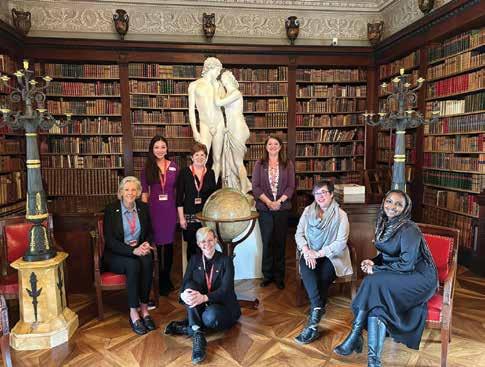
members’ knowledge, and letting other members know where my own expertise lies. is kind of active participation has brought opportunities for me and our city.
Participating in international delegations elevates the pro le of Columbia on the world stage. When a mayor is invited to discuss issues with counterparts from around the globe, it signals that their city is part of a broader conversation — one that transcends borders. It also facilitates conversations that would not otherwise be possible.
For instance, Basel, Switzerland is the headquarters for Novartis — a multinational company leading global e orts in biomedical research. While in Basel, I was able to speak with representatives of Novartis and thank them for their multiyear agreement with the University of Missouri Research Reactor (MURR), which allows them to use our locally produced radioisotopes in their cancer research. I was also able to explain to my peer mayors that Columbia’s MURR is the highest-power university research reactor in the United States, and the only U.S. supplier of the radioisotope. (Yes, I might have been exing a bit.)
In addition to elevating Columbia’s prole, an invaluable aspect of being part of an organization like the U.S. Conference of Mayors is the chance to advocate for federal support for local priorities. Wheth-
er it’s securing funding for infrastructure projects — like our recent grants from the Department of Transportation, totaling almost $30 million for road improvements and transit infrastructure — or advocating on Capitol Hill for a federal-local partnership to improve access to mental health services and housing programs, collective action has ampli ed Columbia’s voice in Washington, D.C.
I want to emphasize that when your mayor participates in international delegations or engages with national associations, it re ects our city’s importance and its aspirations. It underscores our commitment to progress, collaboration, and continuous improvement. As we navigate the challenges and opportunities that lie ahead, let us remain connected, engaged, and proactive in shaping the future of Columbia, Missouri — both locally and globally.
Together, through our collective e orts and partnerships, we can build a stronger, more resilient, and more vibrant community for generations to come.

Bu aloe currently is serving her rst term in o ce as the mayor of Columbia.
What does the Bible o er and how do I read it?
Like anything written that we encounter, we must decide how to read it. Do we need to study it or browse the headlines? Do we need the details or just the overview? Do we read it as news, as art, or for entertainment? Will the content inform us or transform us?
e Bible is no di erent.
When we engage the scriptures, we read for relationship.
Before we dive into that, however, we need to understand what the Bible is and why it is worth reading.
e Bible is a collection of sacred scriptures written by over forty authors on three continents over a span of about ve hundred years. It was originally written in three languages — Hebrew, Aramaic, and Greek, and is the best-selling book of all time. It contains two sections — the Old and New Testaments — and sixty-six core books.
e Bible contains God’s story of creation through the establishment of the early church, and includes the stories of the birth, ministry, death, and resurrection of Jesus Christ.
In his publication titled Eat this Book, Pastor Eugene Peterson talks about Karl Barth, a young Swiss pastor in 1916 who challenged those in his care to read the Bible di erently. Barth believed the Bible was a di erent kind of writing. It was revelatory and intimate rather than informational and impersonal. And he challenged people to read it di erently; to engage it receptively and leisurely.
So, if the Bible is intimate and Barth encourages us to be receptive to what it is saying, then how do we engage it?
WE READ FOR RELATIONSHIP
Reading for relationship has been a new

concept for me in my adult years. Growing up in church, I was encouraged to learn the Bible stories and to memorize scripture. I was fed the content as information, with little expectation that I would do anything with it. I could tell you the stories of Noah and the ark or Jonah and the whale, but I did not know how their stories could impact my life today.
en I was introduced to the contemplatives, to a collection of Christian authors and teachers who were leading people to engage the Bible as a love letter from God.
ey saw and understood the Bible as one, big love story from the darkness before creation to eternity with God in heaven. As I reread those familiar stories, I began to see myself in the narrative and most importantly, to see God in the story.
So how can we read the Bible for relationship? ese four key words will help — read, pray, think, and live.
Take your time and read thoughtfully. Choose a passage of scripture that interests you and read it as part of this epic love story. en read it again. Read it aloud. Need a place to start? Try Psalm 139. Sit with it, absorb it, meditate on it. Eugene Peterson says, “ e Bible is given to us in the rst place simply to invite us to make ourselves at home in the world of God.”
Once you have read the passage and reected on it, notice what God might be saying to you. Is there a particular word or phrase that sticks out to you? Circle it.
Don’t worry about nding the “right” answer; simply listen for what God is revealing to you about him, his love, or the world he created.
Reading the Bible for relationship is as much about listening as it is about speaking. God is yearning to connect with you. Turn the words and phrases he has shown you over in your mind, dialog with him about them. What are you thinking? Feeling? Wondering? How is your body responding to what you are reading? If you have a journal, write your thoughts down.
If we want to engage the scripture for our transformation rather than information, then after we read, think, and pray, there will come a time to act. What is God saying? What is he asking us to do? To believe? To change? How might he be a rming something in us, bringing us peace, or removing fear? Write this down as well.
How could our life and walk with God look di erent if we read the Bible for relationship? I think we will nd a Friend in those pages who loves us, delights in us, and is excited to spend time with us.

Beth Bramstedt is the Church Life Pastor at Christian Fellowship.

Io er my sincere congratulations to the new 20 Under 40 class for their accomplishments in their eld and for our community. As the CEO of Heart of Missouri United Way, I know how important it is for our emerging leaders to focus on the value of giving back. I recently had the honor and privilege of attending the 20 Under 40 reception and fundraiser to celebrate this year’s recipients and speak to the work of United Way.
I was humbled by the class’s collective e orts in organizing the auction to support Heart of Missouri United Way’s Read Across Columbia program. Coming together, they showcased the power of be-
ing united in purpose, action, impact, and hope for our community’s most vulnerable — especially our youth.
e silent auction they put together included many items and opportunities donated by local individuals and businesses, such as a Pasta La Fata Wine Dinner, Lakota Co ee for a Year, and a football signed by Coach Drinkwitz. Our local community came together to not only donate incredible items and experiences, but also to place bids. Our community demonstrated that they, too, are united in purpose, action, impact, and hope, and helped raise $5,000 to provide books to our children.
e Read Across Columbia program places free books in the hands of hundreds of rst and second graders, speci cally those who attend Title One elementary schools in the Columbia Public School District. ese elementary schools have the highest free-and-reduced lunch rates and lowest reading pro ciency scores, and foster the education of the most diverse students in our district.
We have seen the trending local challenges that our young students and their families face, and how third grade reading pro ciency scores have declined by more than 8 percent since the start of the pandemic (Boone Indicators Dashboard).
ird grade is when students switch from learning to read to reading to learn. is important educational switch is signicant in their future success.
We know reading pro ciency is extremely di cult to achieve when combined with other common struggles related to poverty, like food insecurity, and healthy, safe, and a ordable housing. We recognize that as we work with teachers and schools in helping to foster a love of reading, we will help these young students achieve academic and lifelong success. We work together to remove barriers to education and create and invest in programs to help these students thrive.
Due to the success of the 20 Under 40 auction, we can provide even more books for our kids. ese books help remove barriers to literacy and show these students that our community cares.
e United Way team and I appreciate this year’s 20 Under 40 class for selecting Read Across Columbia, and for all who purchased auction items that helped make this fundraiser a success and make a di erence for our community. Each dollar raised, each book donated, and each hour volunteered will contribute to a brighter future for our kids.
You can learn more about United Way’s Read Across Columbia Program at uwheartmo.org/read-across-columbia.

Andrew Grabau has served as the President and CEO of the Heart of Missouri United Way since 2015.
 BY CANDICE BALL
BY CANDICE BALL
By nature, cats are incredibly independent, but they also need comfortable spaces where they can thrive and engage with their surroundings. ey need room to jump, climb, and hide — and of course, a good place to take a cat nap. Because they can be territorial, and often have anxiety when they encounter new places and smells, creating a practical space for their day-to-day lives is an important part of making cats feel at home.
At Bertha’s Beans Cat Café, the primary focus is creating a good environment for cats while they’re waiting for their new families, and making sure those families are prepared to welcome their new furry family members into their homes. Bertha’s was born last summer, when the owners of Lizzi & Rocco’s took over ownership of the existing cat café at 14 S. Second St. eir team renovated the space to accommodate a large cat
family, partnering with Columbia Second Chance rescue.
Named for Lizzi & Rocco’s rst permanent resident, Bertha the cat, the space has been designed to o er a place to meet and interact with cats looking for their forever homes — and also to enjoy drinks and snacks. Manager Jaylynn Gentry worked with the team to help create a space where people and cats could interact and build relationships.
“Since we o cially opened in November, we’ve had about ninety adoptions, and we just feel great about that,” Gentry said. “What makes us unique is that we have a lot of knowledge and resources to share with people who come in, in terms of everything a cat needs: diet, environment, and everything. We’re always so excited when an adoption happens — and we also send everyone home with a welcome bundle, so they get a checklist of everything they need.”

Bertha, the original resident cat, died after a long-pampered life. Currently, Beans, Freddy, and Chai are Bertha’s three resident cats — the only ones not up for adoption. e others are all looking for a place to call their own. Normally, there’s a population of around twenty cats that stay on site — and a wide variety of people visit the café.
“ e majority of our customers are college students,” Gentry said, “but we also see a lot of parents with their kids, and we also have our diehards, just people who love cats, so they come here to read a book, have a cup of co ee, and just decompress. ey get to know the cats on pretty personal levels.”
One side of Bertha’s is the café — where you can eat and drink — and the other side is the cat area. On the café side, you can sit, relax, and watch the cats interact with their surroundings through a large window. On the cat side, you’ll nd a wide variety of toys, cat trees, and other interactive items (all of which are available at Lizzi & Rocco’s).
ere are also custom-made benches that have hidey holes in them, so the cat family can retreat for some privacy, when needed. ere are runners, which are like shelves, close to the ceiling, with stairs and holes, “just so the cats can run around, escape, and just play,” Gentry explained.
Bertha’s also has a large cat wheel. Gentry says right now, most of their cats use it to nap in, but more energetic cats will appreciate the exercise.
Preparing your home to receive your new cat is extremely important, too. Gentry said that while people often think adopting a cat is less work than adopting a dog, you need to create a place for your cat to be both comfortable and stimulated.
“When people adopt a cat, there’s a lot that goes into it,” Gentry said. “For example, some cats like to scratch furniture, because it’s in their nature to scratch. So, it’s really important to have things like scratching posts and trees, because it decreases their stress levels and keeps their nails in good shape.”
She continued: “Cats do get bored. ey’re more independent, but they do need things in their environment to make them feel comfortable. Some cats prefer to have water fountains, because
they like the running water; others don’t like that at all. If you have a younger cat, he might want a playmate; if your cat is older, you might want to consider letting him be solo. All cats have di erent personalities, so we want to make sure you get to know your cat and what he likes.”
Once you nd your new feline friend, your possibilities are endless for creating a cat friendly space in your home. You’ll want to organize the space so it’s safe, comfortable, and quiet, and so your cats can play and rest when needed. One popular option is the catio, which is ideal for indoor/outdoor cats. A catio allows cats to lounge inside and engage with the outside world as they choose, while keeping them safe from external hazards, like predators and the elements. Catios are typically designed as an extension of the home.
Columbia residents Miranda Wilkerson, her partner Heather Richmond, and their daughter, Adah, opted for the catio. It’s an enclosure that extends from their window. eir cats — Maybelle, age 17, Gary, age 15 (who is also a tripod), and Smokey, six months — share their home with a dog, Tina. eir family needed to make sure everyone could live together in harmony.
“My cats are so nice,” Richmond said, “but Tina doesn’t always like them so much.”
Wilkerson’s father built the catio, which has created a practical solution to help their entire family — both the people and the fur babies — share space.
“Smokey has sort of emerged as the alpha in our house because he’s younger. He’s much more likely to interact with Tina, while the older cats are set in their ways,” Wilkerson explained. “At the same time, Tina is a happy dog and well-trained, but she isn’t always sure how to deal with the cats. So normally, Tina keeps to her own area, and the cats have their own place.”
Wilkerson agreed that the most important part of setting up a pet-friendly home is to make sure you know your animals’ personalities and preferences.
“I’ve always been a cat person,” she said, “and all cats are di erent. My older cats are really di erent from Smokey, so the catio was a good project to make sure everyone has a place to be where they’re comfortable. We try to make



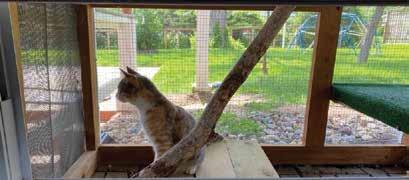
sure they have new entertainment and to create comfy spaces for all of us to enjoy.”
Gentry seconded that notion. “Some of our cats come to us as strays. Some were raised as housecats. Some are younger, some are older, some like to socialize, and some like to hide. ey’re all di erent. Getting to know your cat is like getting to know a person. All personalities are di erent.”
If you’re looking for a kitty to bring into your family, visit Bertha’s and get to know the possibilities. Bertha’s currently operates on a walk-in basis, but you can call or email to make arrangements if you want to come with a larger group for some cat fun. ere’s an application process through Columbia Second Chance’s website, along with a $60 fee (and they’ll include a carrier for an additional $5), and they o er a ten day trial period, so you can make sure your new cat is the right t for your home, and the additional people and animals they’ll be sharing their lives with.






 AUSTIN MCBRIDE
AUSTIN MCBRIDE
You spend valuable time and resources to be sure you get just the right paint colors and that everything matches perfectly before the painting begins. Ai Painting Plus works with you every step of the way to ensure you and your family’s well-being is part of the process. And that includes your furry friends, helping you make the best decisions to keep your home vibrant and your pets healthy.

Keep an Eye on Your Pets
Our pets are more than animals; they’re family. However, many homeowners aren’t aware that traditional paints contain chemicals harmful to pets. This realization underscores the importance of choosing pet-safe paint, ensuring our homes are safe havens for every family member. Pet safe paints are specially formulated to minimize health risks for pets, meaning they are free from or have low volatile organic compounds (VOCs). When shopping for pet safe paint, look for certifications like “Low VOC” and “Non-Toxic.” This choice ensures a healthier living environment, free from the airborne toxins typically associated with traditional paints. Both pets and humans will breathe easier, enjoying a cleaner, fresher atmosphere.
The finish of your paint does more than just affect the look of your walls; it also impacts maintenance and durability. Glossier finishes, for example, are easier to clean and resist wear and tear better than their matte counterparts. For households with pets, opting for a durable, easy-to-clean finish can make a big difference.
Austin Ilsley, co-owner started Ai Painting Plus in 2013. From the age of 16 he started working with other painting companies which gave him a solid foundation for performing the work and running a company dedicated to professionalism both with himself and his crew. In 2021, his wife Lacie Ilsley became the new Owner. Since the start of this company, she used her skills to grow the business and create an enviable company culture in the Columbia community.

Our dog, Luna, loves smiling at you, playing fetch and cuddling.
Even if you’ve taken all the necessary precautions, it’s still important to keep an eye on your pets while the job is being done. If you have hired professional painters, make sure they know that you have pets in the home and ask them to keep an eye out as well. If you’re doing the job yourself, take frequent breaks to check on your furry friends. They may be curious about all the activity and want to investigate!
• Distress. Home painting projects can cause pets to feel distressed due to unfamiliar smells, people, and sounds in their home.
• Injury. Tools and equipment on the floor during home painting poses safety risks to pets and painters, including tripping, chewing, and equipment damage.
• Painting Issues. Pets can delay and lower the quality of a paint job by interfering with the process, damaging protective materials, or rubbing against newly painted surfaces.

• Keep Pets Away from Doors. Pets may try to escape when painters frequently enter and exit your home with supplies and equipment. If you are keeping your pets at home during the painting process, keep your pets away from the door. Consider using a gate or confining them to a safe area away from the working space to prevent any unwanted escapes.
Work with a Pet-Friendly Painting Company
At Ai Painting Plus, we know that your pets are part of your family — because they are a part of our family. We will provide a petfriendly painting experience that puts your fur baby’s safety and well-being as a priority. We strive to make sure that our painting process is stress-free — for both you and your furry friends.
F or homeowners, getting a new roof installed is an exciting time but the process can be stressful if you are not prepared. Here is the roofing installation process explained so that you can understand what to expect.
Before you can sit back and watch the construction crews do their work, you need to make sure your home is prepared for the crew’s arrival. This means you need to move your cars out of the driveway and move any lawn ornaments away from the perimeter of your home. Some debris will be falling from your roof so you want to make sure there is nothing that could be damaged nearby. In addition, on the day of installation, it is important that all animals and children be kept inside and away from the perimeter of the house to ensure their safety.
The first step in getting your new roof is, of course, material delivery. One to two days before your installation is scheduled, materials will be delivered and loaded directly onto your roof by a boom truck. For some homes with low hanging power lines or trees, loading the materials on the roof may not be possible. In these instances, the materials will be placed in the driveway and the delivery crew will do their best to not block any vehicles.
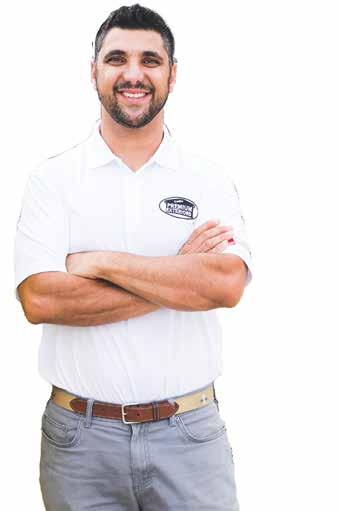
CoMo Premium Exteriors is mid-Missouri’s largest roofing and exterior remodeling company. We believe in providing homeowners and business owners with free, honest inspections and advice to help them make informed decisions. We never use high pressure tactics because our goal is to build long-term relationships built on quality workmanship, great communications, and good cleanup when we’re done. If you need a new roof, gutters, siding, windows, or a deck; we’ve got you covered!

The crew will come early in the morning on your previously scheduled date and begin by backing a trailer as close to your home as possible. This trailer will be (573)
where the crew dumps the old shingles they remove. The crew will also put tarps around the home to protect your yard, and sheets of OSB will be leaned against your home to protect your siding and windows from possible falling debris in the area where the trailer is parked.
The roof will be torn off down to the wood decking. When the wood decking is exposed, the crew will inspect for any rot or weak, flexing spots where there may be broken rafters. If they find any problem areas, they will call the CoMo Premium Exteriors’ production team to have the appropriate materials brought to the site. These repairs are very important and will be made the same day so your roof installation can continue as planned.
Once the crew has ensured that the base of your roof is in good condition, they will go in with the ice and water barrier and install that around pipe boots, the valleys of your roof, and any other vulnerable areas where there are seams or openings.
After the ice and water barrier has been adhered to the roof in the appropriate areas, a layer of synthetic felt paper is installed over the wood decking. With all the protective layers installed, several types of shingles can go on.
After everything is sealed and inspected one last time, the crew will pick up any large debris around the house and run a magnet around the home to collect nails that may have fallen. The house will be circled several times to get as much debris as possible. If a customer feels the clean-up wasn’t sufficient, they can call anytime within the first year and a crew will come back for free to clean-up again to ensure you are satisfied.
If you are interested in a roof replacement or roof repair, call CoMo Premium Exteriors to begin the process. We can schedule a roof inspection with one of our roofing experts to explain this process more thoroughly and let you know the best course of action for you.
In North America, landscape irrigation water use averages more than five billion gallons each day. Over half of this water is wasted due to overwatering caused by inefficiencies in conventional irrigation methods and systems. Smart irrigation systems offer economical, practical, and sustainable solutions to the shortcomings of traditional watering.
Smart irrigation systems use Wi-Fi and app-based capabilities to automatically adjust watering schedules and run times for optimum water coverage to individual landscapes. These systems significantly improve outdoor water use efficiencies. Whereas traditional irrigation systems operate on preset programmed schedules and timers, smart irrigation controllers monitor rainfall, temperature, evaporation, and water use to automatically adjust the watering schedule to the conditions of the site.
It is quick, easy, and affordable to upgrade a conventional irrigation system to a smart irrigation system, and a controller upgrade can be done within few hours. Hiring a professional company for installation will ensure that the smart irrigation technology is seamlessly integrated with an existing system. Some of the main advantages of a smart irrigation system include:
Smart irrigation controllers can be controlled remotely through apps, and support voice controls with popular smart programs like Alexa and Siri. Notifications for run times, water usage, watering schedules and system troubleshooting can also be sent to the user via the app. Your system can be actively configured to respond to changes in weather and water flow, while providing you with up-to-the minute run time and usage information.
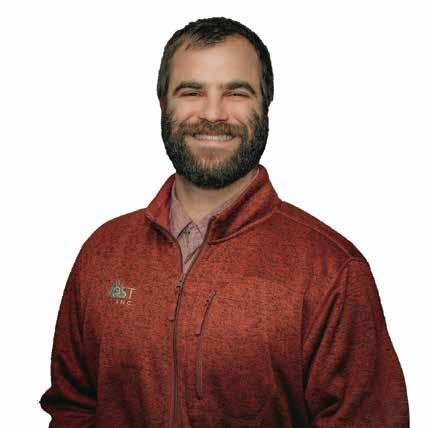
Many smart irrigation controllers can wirelessly link to a local weather station to receive periodic weather updates. As outdoor temperatures increase or rainfall decreases, smart irrigation controllers can adjust watering run times or schedules according to changes in rainfall and temperatures. Smart irrigation systems can also monitor soil moisture at various depths and gradually reduce drip irrigation safely above the wilting point.
Conventional watering methods can waste over half of the water used due to inefficiencies in irrigation, temperature, and overwatering. Smart irrigation systems use sensors for real-time data to update watering routines and adjust watering schedules to improve efficiency, and work in tandem with local weather station information to make changes and adjustments to watering schedules based on precipitation and temperature.
In addition to smart irrigation systems being great way to conserve water, they can also reduce runoff, overwatering, and erosion. When a lawn is saturated, the excess water
Austin is a Sales Manager for irrigation, lighting, fencing, and estate gates at Rost Landscaping. He is also a Professional Water Witcher. When he is not on the job he enjoys hunting, fishing, raising livestock, and be being a full time family chauffeur.

will often travel to other properties, roadway sewers, or nearby waterways. This runoff may carry with it chemicals and pesticides that the lawn has been treated with. Smart irrigation technology contributes to water conservation, soil stability, and cleaner water resources for wildlife by eliminating excessive or unnecessary watering.
The irrigation industry is experiencing exponential growth in new technology, and there is a wide range of smart irrigation products that utilize advanced sensors, Wi-Fi and app-based capabilities. By investing in smart irrigation technologies, you can save water, money and time in caring for your landscape. Be sure to consult a Rost Superior Irrigation representative to see what smart irrigation system will work the best for you.
Homeowners often dream of refining their living spaces with the beauty of hardwood floors or upgrading to a modern tile in their laundry, bathroom, or kitchen spaces, but worry if hardwood can withstand their family’s active lifestyles and if the expense to change out tile is worth the investment.
Luckily, luxurious vinyl flooring brings the beauty of stone, tile, and hardwood flooring with affordable oops-proof, petproof, and waterproof durability.
What makes vinyl or resilient flooring so durable? It’s a composition of four layers of synthetic materials including:
The Wear Layer
This durable top layer is a protective seal to keep your floors scratch-free. Any scuffs or spills are easily removed with a quick sweep or a damp towel.
The fun part of finding new floors is choosing the color and design. With LVT or LVP, there are multiple, colors, textures, and finishes to brighten any room.
The Rigid Core
Typically composed of PVC and other synthetic materials, the rigid core stabilizes vinyl flooring.
The bottom or back layer provides the base structure and waterproofing properties to the under-layer of the flooring

When you are searching for vinyl flooring, you will also come across the terms SPC and WPC. SPC stands for stone plastic composite, the core that gives this flooring its incredible durability and rigid ability to maintain its form over uneven surfaces. WPC or wood-plastic composite is enhanced with a foaming agent making it slightly softer underfoot.
Michele Batye is a female entrepreneur and Certified Missouri Women’s Business Owner of Flooring America, a locally owned full service flooring center offering a diverse range of flooring options for both retail and commercial markets.

When installing a “floating” floor it is important to know the installation process as well as the floors limitations. With any “click together “or interlocking installation system there is a tolerance in how level your sub-flooring must be for the flooring to properly function. Luckily these waterproof products are also available in glue-down systems; this installation technique is perfect for high foot traffic, uneven and concrete subfloors.
Why is luxury vinyl flooring so sopular?
While many floor options boast water resistance, luxury vinyl products are fully waterproof, making them ideal in all rooms, especially kitchens and bathrooms. The use of high quality digital photography has changed the flooring industry, allowing homeowners to have the look of natural wood and stone products while not losing
the ease of mind that comes with durability and easy care and cleaning.
How do you choose the right luxury vinyl flooring? Our Room to Explore system makes it so simple. Choose the color and texture that is right for you and look for our H20 symbol, guaranteeing the product is 100% waterproof. Next let our team of Experts help you decide on the right core and installation system that is best for your home and lifestyle.
We offer professional measuring; consultation and installation services, we even offer an exclusive Adore Your Floor Guarantee to make sure you are completely satisfied with your choice. Come into our showroom at 801 Business Loop 70 East or explore our products at davegriggsflooringamerica.com.

CO-OWNER, SALESMAN, AND DESIGNER
In the heart of Missouri, a story of passion, dedication, and excellence unfolds with every nail driven and every shingle laid. We are brothers-in-law Austin and Cody, and we lead the team of more than 35 talented individuals at Heartland Homes Remodeling and Roofing. What began as a shared dream in 2013 has blossomed into a thriving enterprise, setting the standard for quality and customer satisfaction in the remodeling and roofing industry.
Heartland Homes is united by a vision to redefine the remodeling and roofing experience. With roots deeply planted in Columbia, we have cultivated a company culture centered around honesty, quality craftsmanship, and the unwavering commitment to turning dreams into reality. Our journey from humble beginnings to industry leaders is a testament to our relentless drive and unwavering dedication.
From the outset, at Heartland Homes, we have set ourselves apart by placing core values at the forefront of every project.
CODY GARCIA
CO-OWNER, SALESMAN, AND DESIGNER

Where quality meets recommendation! Columbia’s goto for exceptional remodeling and roofing services.
Trusted by the community, we turn visions into reality. Your dream space starts here!


Honesty permeates every interaction, from initial consultations to project completion, fostering trust and transparency with clients every step of the way. Quality is not just a buzzword but a guiding principle, evident in the meticulous attention to detail and superior craftsmanship that defines each Heartland Homes creation.
But perhaps what most sets Heartland Homes apart is our passion for making dreams come true. Whether it’s a kitchen renovation, a bathroom remodel, or a roofing project, our team approaches each job with a deep sense of purpose, understanding the profound impact that a well-executed project can have on a homeowner’s life. It’s this commitment to excellence and customer satisfaction that
has earned us the title of “Best in Columbia” year after year.
As our company continues to grow and evolve, so does our reputation for excellence. With a team of dedicated professionals who share their vision and commitment to quality, we are poised to take Heartland Homes to even greater heights. But amidst our success, we remain grounded in our roots, never losing sight of the values that have guided us from the beginning.
For those in search of a remodeling or roofing partner who shares our values and exceeds expectations, Heartland Homes stands ready to bring your vision to life. The possibilities are endless, and the results are nothing short of extraordinary.
Melody Whitworth was not an animal-obsessed child; one may assume that about the founder of a dog rescue. She found her love for animals later in life after caring for her own pets and working in a high-kill animal shelter in Naples, Florida. Whitworth’s time at the shelter opened her eyes to pet owners that can easily abandon their animals — or even starve a pet to death.
“I had a really hard time wrapping my head around it and accepting it. And an even harder time with the general public thinking it’s okay,” said Whitworth. “I think it (the attitude) is slowly changing, but there’s just still so much of it. Animals are as innocent as children. ey just can’t help themselves. ey’re at our mercy. ey give us so much. We should give it back to them.”
Later, Whitworth’s romantic relationship brought her to Columbia. While searching for a new home with enough space for her rescue horse, she was disturbed by the number of tethered dogs she saw just outside Columbia’s city limits.
“ ere was a Husky chained to the tree. It was the middle of August. No water, just dry dirt all around it, jumping up and down, yanking its neck at the end of a chain,” she recalls. “I’ve told this story multiple times, but it’s the honest
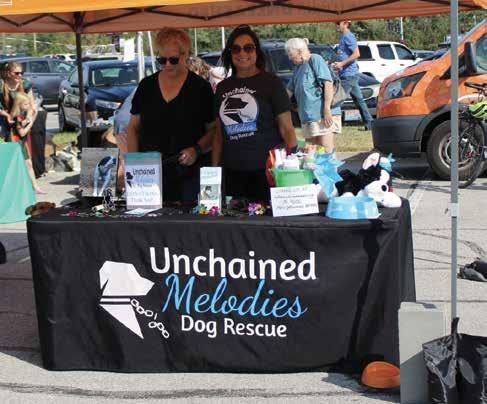
truth; that was my destiny. I wanted to get help for that dog, and I just couldn’t nd help.”
Whitworth acted. First working with a Virgina-based anti-chaining organization, in 2015, Whitworth transitioned to her own 501(c)(3) called Unchained Melodies. e name is a play on words from Whitworth’s rst name and the organization’s mission to advocate for chained and penned dogs and rehome those dogs into responsible, loving, permanent families.
“Animals are as innocent as children. They just can’t help themselves. They’re at our mercy. They give us so much. We should give it back to them.”
“What we’re ghting against is dogs that live tethered in some form,” she said. “ ese dogs are out there day after day, week after week, month after month, and year after year. ey live their entire lives at the end of a tether.”
Whitworth uses chains when describing tethers because chains are most often used for dogs tethered for an extended amount of time after the dog has learned how to break away from other materials. It’s common for Whitworth to see dogs’ chains padlocked to prevent further mobility.
“When a dog is initially tethered to a tree, it’s yappy and barking. It’s jumping around going crazy asking ‘Why am I out here?’ and then little by little, the dog just stops barking because no one comes,” said Whitworth. “After a while, the dog becomes very withdrawn and depressed; that to me is abuse.”
Unchained Melodies may work with neglectful dog owners for years before an animal is relinquished. Every owner signs a release upon turning over their dog. e Missouri Department of Agriculture monitors the nonpro t to ensure all animals are lawfully collected.
New dogs in Unchained Melodies’ custody are rehabilitated and trained as needed. Until adoption, most dogs live in
Unchained Melodies rescues, rehabilitates, and rehomes chained, penned, and abused dogs that have no voice. We fight for stronger laws and have many programs that benefit our community.
• Walking and working with dogs at the training facility, performing light cleaning and washing dishes, and more.
• Helping with adoption, fundraising, and outreach events throughout the year.


• Helping with administrative tasks like data entry or follow-up phone calls to adopters.
• Helping transport dogs to and from the vet for spay/neuter surgeries and other medical needs or picking up dogs who need help reaching their foster homes.
• Volunteer in the puppy nursery by feeding, walking, and cleaning up after the mommas and babies.
• Become a foster home. In order to rescue dogs, UMDR needs foster homes willing to provide a temporary home while our dogs await adoption.
foster homes. Some more challenged dogs live at the 5,000-square-foot training facility Unchained Melodies moved into in 2018.
Unchained Melodies rescue, rehabilitation, and rehome program directly helps about 200 dogs annually.
e outreach has assisted tens of thousands of dogs throughout Missouri.
“We have very low numbers compared to other organizations because of the training and rehabilitation we do,” Whitworth said. “We don’t push the dogs through the training. ey move at their own pace. When they’re ready, they’re ready.”
Whitworth is Unchained Melodies’ sole full-time employee. A team of subcontractors, trainers, and volunteers supports her. rough Whitworth’s passion, Unchained Melodies’ mission has spread throughout the state, especially to Southern Missouri, where much of the nonpro t’s work has happened over the past few years.
Whitworth has taken her passion to the Capitol, advocating for the writing of HB 2450, which “establishes the o ense of unlawful tethering or chaining.” Along with volunteers, Whitworth supported the bill in January at the Capitol. Whitworth is familiar with this type of advocacy, having been a key player in Columbia’s 2018 amended animal tethering ordinance.
She said Unchained Melodies feels well-respected in the community and supported by community partners including Animal Control, the Columbia Police Department, and the Boone County Sheri ’s O ce, among others. Whitworth especially feels community love during CoMo Gives, an annual online fundraiser that supports high-impact nonprofits in Columbia and mid-Missouri. As a nonpro t solely dependent on private donations, annual giving programs are incredibly bene cial.
Columbia also bene ts from Unchained Melodies’ other programs open to the entire community. Six-week training courses, specialized weekend workshops, and social hours are among the programs available to help train dogs and their owners on dog behavior.
“People used to drive by and say, ‘Oh, poor dog, I wish there was something I could do.’ Now they know there is something they can do,” Whitworth explained. “ ey can reach out to us.”
UNCHAINED MELODIES DOG RESCUE
P.O. Box 7018
Columbia, MO 65205 (573) 814-8073 unchainedmelodies.org

Deep in the heart of the Midwest, there is a plethora of coyotes and raccoons and bears — oh my! But within closed doors and warm homes, it hardly feels like an impending danger or threat to our u y pets, the once ferocious leaders of the land, now curled up in our laps begging for belly rubs.
Lately, there has been a movement growing and spanning that harks back to our pet’s primal instincts, o ering them a taste of the wild within the comforts of home. But what exactly is raw pet food, and why are so many pet owners ocking to this unconventional feeding method?
Picture this: your furry companion, ancestors of the mighty wolf, roaming the untamed wilderness in search of sustenance. In the wild, their diet consisted of raw meat, bones, and organs — a nutritionally complete feast that fueled their predatory prowess. Fast forward to modern times, and domestication has softened their edges, but the call of the wild still echoes in their DNA; it’s genetic.
eir bodies are still highly acidic, leading to any worrisome bacteria being quickly fought o from a raw meal. Raw pet food aims to reignite that primal spark, providing our four-legged friends with a diet that mirrors their evolutionary heritage.

e founders of Lizzi & Rocco’s Natural Pet Market — Jessica and Kyle Schlosser — are pioneers in the raw pet food movement and champions of canine health and vitality. eir journey began with a boxer named Lizzi, whose battle against cancer sparked a quest for optimal nutrition. Determined to give Lizzi the best chance at a healthy life, they delved into extensive research, uncovering the potential bene ts of raw feeding.
Recognizing the detrimental e ects of carb-heavy diets on cancer-prone breeds, they saw raw feeding as a proactive measure to starve potential cancer cells. e results were profound. Lizzi's transition to raw feeding brought about noticeable improvements in her health, from reduced shedding and smaller stools to an overall increase in vitality. Witnessing these positive changes, the Schlossers were inspired to extend their raw feeding approach to all their pets, ensuring that they also bene ted from the nutritional advantages. rough the Schlossers’ dedication and commitment, they have not only enhanced the health and well-being of their own pets but have also become advocates for the transformative power of raw feeding in the wider pet community through their business.
With a similar story, Madison Runnels — a professional dog trainer — found herself on an uplifting journey into raw feeding. Inspired by her Cavalier King Charles Spaniel, Fix-It Felix, she decided to make the switch. Despite struggling with various health issues and food aversions, Felix's transformation after a month of raw feeding was remarkable.

Runnels plated The Bones and Co Raw Beef Mince, Raw Kefir, Primal Elixers Power Greens frozen into cacti molds for her canine companions.



Wondering what the knobby, bumpy, maze-like plate is that these pups are eating from? Lick mats are a relatively new way to feed your furry friends. They offer a slowing component to an animal’s meal time and are thought to provide mental stimulation as well as feeding their problemsolving instincts.
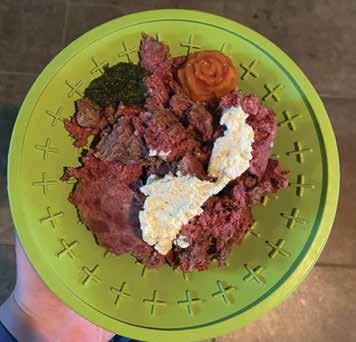



Runnels emphasizes, “One of the biggest bene ts of raw food is the transparency the companies have. You can nd out exactly what farms the meat comes from, what the animals were fed, how they were made into food, and how they got to you. I love knowing exactly what I’m putting in my dogs’ bodies. I want my dogs to be around as long as possible, and while feeding raw doesn’t turn your dog immortal, it does help reduce the chances or delay the onset of health problems.”
Raw feeding's bene ts extend beyond health improvements, o ering a solution for dogs with allergies and promoting dental health through natural bone chewing. Runnels highlights the joy of crafting diverse meals for her dogs, incorporating various ingredients.
“I mix up the proteins, I add goat milk, fruit and veggie purees, whole organs like chicken hearts, quail eggs, and more,” she continues. “It makes me so happy to see my dogs excited to eat their food and getting to know what their favorite foods are. I think everyone should try to feed their dogs fresh food, even just as a topper a few times a week. It’s been the best thing I’ve ever done for my dogs.”
Venturing into the realm of raw pet food can feel like embarking on a jungle expedition — dense with information, teeming with opinions, and rife with potential pitfalls. Seasoned guides like those at Lizzi & Rocco’s or the author, Dr. Karen Shaw Becker, light the way. With years of experience and a wealth of expertise, they've all carved a path through the underbrush of misinformation, o ering pet owners a clear route to raw feeding success.
Embarking on a raw feeding journey requires careful preparation and a willingness to embrace the unknown. Pet owners must familiarize themselves with the principles of raw feeding, understand their pet's nutritional needs, and select high-quality ingredients that align with their goals. e Schlossers are emphatic: Whether you choose pre-prepared, frozen raw meals or pre-made raw patties, the key is to research and provide your pet with a balanced and nutritious diet. Without proper research and understanding, this
switch in diet can result in a damaging outcome for pets.
Feast
Raw pet food isn't just about satisfying hunger; it's about nourishing your pet from the inside out. Packed with bioavailable nutrients and free from arti cial additives, raw diets o er myriad health bene ts for our furry companions.
“Certainly, one of the most rewarding aspects of raw feeding is the remarkable improvement in dental health,” Jessica says. “A raw diet not only keeps teeth clean but also promotes gum health, ensuring our pets maintain strong and healthy smiles.”
ere are numerous other bene ts from improved digestion and enhanced coat health to bolstered immune function and increased energy level. e advantages of raw feeding can be diverse and impressive.
One common misconception about raw pet food is that it's a luxury reserved for the elite. However, with careful planning and savvy shopping, raw feeding can be a ordable. By incorporating raw elements into your pet's diet — such as raw beef liver, bone broth, or goat's milk — a few times a week or opting for budget-friendly raw options found at select pet food stores such as Lizzi & Rocco’s, pet owners can provide the bene ts of raw feeding without breaking the bank.
“Do as good as you can within your budget. Some is better than none. at’s always been our whole philosophy,” Jessica advises. “So if you're supplementally feeding it, you can do it for like less than $10 a month depending on how you’re doing it because there are so many di erent ways to add raw food.”
After all, a journey into the wild doesn't require a hefty price tag.
As pet owners, there is a responsibility to nourish our companions. Raw pet food is an option, o ering a gateway to the wild side, allowing pets to experience a nutritionally complete, nature-developed diet. If there is interest in the herd, heed the call of the wild, complete thorough research, and embark on a journey to raw feeding enlightenment. e path may be unconventional, but the rewards could be boundless.




The great migration has started! No, not the exodus of college students from our lovely town, although that is great cause to celebrate. Nor is it the return of the hummingbirds and other wonderful summer inhabitants of mid-Missouri, which make our gardens and backyards more interesting throughout the warm weather months. e reason we Epicureans are excited is because of the return of the regal inhabitants of North Paci c estuaries — the salmon.
Why, you may ask, is this occurrence so momentous? One reason is simply the amazing life cycle of the salmon. Most salmon in the world are anadromous, which means that they begin their lives in freshwater rivers, venture out to saltwater oceans, live there for years until they get the urge to reproduce, then return to fresh water — almost 90 percent of them to the same river they came from — to reproduce and die! I hope it’s good for them!
e other reason, and for those of us in the culinary world the most important reason, is that the Alaskan sheries are about to open. is means that we are about to see the wild Alaskan salmon — Kings, Cohos, and Sockeyes. For those of you who like salmon and have never had any of the preceding, the di erence between wild and farm raised is like the di erence between round steak and T-Bone. e wild salmon have stored up plenty of the good Omega-3 that we all need, and their natural diet, combined with the frigid waters they live in, contribute to a much richer, more intense avor.
e rst salmon of the season are just coming in but are outrageously expensive. As supply increases, and the initial exclusivity decreases, prices will moderate somewhat. Premium catches to look for, which will be available in limited quantities, are those from the Copper River, American River, and Yukon River. Although these exceptional catches command a pretty penny, you should splurge at least once, just to see what you’ve been missing. Look for these at your favorite specialty food market! Salmon can be grilled, broiled, baked, sautéed, and even fried. Try it smoked or cured as gravlax (with an ice cold shot of aquavit!). Or mix some leftovers up with some onions, breadcrumbs, and spices for croquettes — the possibilities are numerous. Here’s a good one to try on a nice spring or summer day.
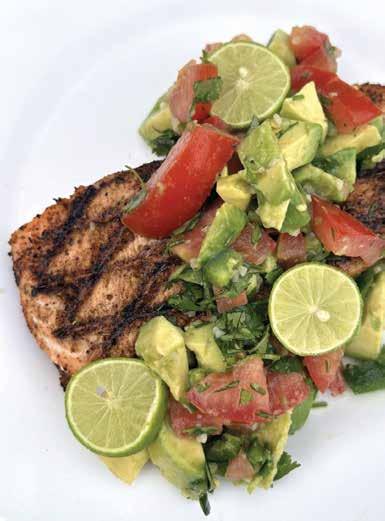
• 4 - 8 oz. wild salmon llets, skin on
• 1/2 c. soy sauce
• 1/8 c. fresh lime juice
• 2 tbsp. Hoss’s Southwest spice
• 1-2 ripe Haas avocados, cubed
• 2 tbsp. roughly chopped cilantro leaves
• 1 clove garlic, minced
• 1/4 c. seeded and chopped fresh tomatoes
• 1/2 lime, juiced
• Jalapeño, to taste

• Salt and pepper
DIRECTIONS
1. Combine marinade ingredients and marinate the salmon llets in this mixture for 1-2 hours.
2. Mix ingredients together.
3. Once marinated, grill the salmon over a charcoal re until medium, about 150 degrees.
4. Spoon the relish on the salmon. Enjoy.
Jim “Hoss” Koetting is a retired restaurateur/chef who enjoys gardening, good food, good bourbon, and good friends.

Pet porker Truffles lives ‘in the lap of luxury.’
BY KELSEY WINKELJOHN | PHOTO BY ANTHONY JINSONPicture yourself on a game show like Family Feud . e host’s prompt echoes, “Name a common household pet,” and you have seconds to respond. It seems easy enough, right? Your mind would likely conjure images of a cat or dog. Depending on who you are, you might also think of a sh, bird, hamster, or rabbit. However, if your initial response to the prompt was “pig,” you’d probably nd yourself out of luck.
While domestic pigs may not enjoy the same level of popularity as traditional housecats or dogs, they’ve surprisingly gained traction in the United States over the years, particularly during the 1970s — though more as a fashion accessory than anything — and in the ‘90s and 2000s. Advertised as teacup pigs or mini pigs with the promise of perpetual smallness (myth), they often captured the interest of families with children and younger individuals.
Maggie Hynes, a Stephens College alumna, hadn’t necessarily planned to adopt a pet pig. e emergence of mini pigs happened to coincide with her sophomore year of college and because Stephens is a petfriendly campus, the college did not hesitate to accommodate her when she proposed the idea of adopting one.
“ ere was this mini pig farm in Florida,” she recalls. “ ere were like 300 other pigs running around and Tru es was the only little white pig in a litter who just looked like she wanted to be picked up.”
Tru es, a mini pig with a touch of the Juliana breed, was around eight pounds and the size of a Venti Starbucks drink when Maggie adopted her.
Fast-forward to eleven years later, Tru es has long been gone from the dorms and now lives with Maggie, her wife, Jessi (also a Stephens alumna), and
their cat, Puddle — and their porcine pet sure does keep their lives entertaining.
In some ways, Tru es is similar to cats and dogs. She knows tricks, uses a litter box, and loves to cuddle with Maggie and Jessi in bed.
On the other hand, Tru es is more intelligent than cats and dogs; in fact, pigs are believed to be as smart as threeyear-old children. Tru es knows over a hundred tricks, including identifying speci c toys, recognizing colors, following hand and voice commands, and playing the bongos. If there’s any trick that Maggie and Jessi think of, they can usually teach Tru es how to do it by the end of the day.
“When I was in college, Tru es learned how to open my mini fridge, just from watching my morning routine,” Maggie says. “I suddenly realized she can get into the fridge and pull things out, so I had to move it.”
Jessi laughs, “We’re a childless home that’s baby-protected and baby-gated. If you were going to compare [having a pig] to any other pets, it’s like having a dog and a baby at the same time.”
While cats and dogs often get into trouble due to their animal instincts, Tru es likes to be naughty to get attention — a behavior the couple calls “being mischievous with a purpose.” For example, she isn’t allowed in the bathroom, but she’ll go in, close the door, and wait for Maggie or Jessi to nd her. Tru es also pretends to rummage in the recycle bin to see if anyone will notice and catch her in the act.
As with any pet, it’s essential to do your research before adopting. ere are substantial responsibilities when it comes to owning a mini pig — and they have di erent needs than more traditional pets, too.
Many prospective mini pig owners underestimate the amount of e ort involved in caring for their pet, persuaded by how cute and small the young pigs are and how easy the caring process is in the early days. It’s important to understand that caring for a mini pig entails more than just their initial appeal suggests.
“It takes a lot of extra time and preparation to care for her,” Jessi explains. “We kind of suit our whole lives to Tru es. We have a car ramp so she can get in and out, and I built a fteen-foot ramp on our stairs to take her outside because she can’t go down the stairs. It’s just ever evolving.”
“And you need to give pigs a lot of attention,” Maggie adds. “Because they are so smart, they can get very bored. My whole day revolves around doing things for Tru es.”
Mini pigs can become destructive when they are bored, which may involve eating drywall and pulling up carpets. Because pigs are as intelligent as toddlers, they can’t be left alone for long periods as a cat or dog could be. Pigs are also emotional creatures that require regular one-on-one time with their owners.
2.
3. Though
4.
5.
In general, though, Tru es lives a relaxed life. She isn’t an early bird, so after Jessi feeds her at 7 a.m., she goes back to sleep until lunchtime. Afterward, Tru es enjoys playing with her snu e pad and toys while Maggie prepares for the day. Tru es also spends plenty of time outdoors, eating grass, digging in hay, and lying on her pillow.
“She kind of lives in the lap of luxury,” Jessi says. “She gets dinner, which consists of mini pig food and fruits and vegetables … and then if we’re watching TV or playing video games, she might be upstairs with us, hanging out. She even has a heating blanket.”
In contrast, providing pigs with their own space to retreat is essential, and it should be respected. Tru es, for example, has her own room, equipped with a ten-foot by ve-foot cage for sleeping, a litter box, and her food bowl. Her owners only enter her room when necessary for cleaning.
Diet and exercise are also critical to caring for mini pigs properly. Without proper exercise and feeding, mini pigs can gain excessive weight, leading to health complications such as joint and mobility issues, and a shorter lifespan. To prevent this, Tru es is frequently walked on a leash and fed according to her veterinarian’s advice, with added supplements.
“It is a lot of work,” Maggie says, “but I do enjoy it.” When asked if she would do it all over again, Jessi jumped in to answer, chuckling: “She [Maggie] just asked me for another pig yesterday.”





e domestication of canines began some 15,000 years ago, transforming dangerous predators into productive workers and comforting companions. What we don’t know, exactly, is when humans discovered that this combination could tangibly enrich our lives.
A fresco depicting a blind man led by a dog was discovered among the ruins of the ancient Roman city, Herculaneum (which, along with Pompeii, was destroyed and buried in ash when Mount Vesuvius erupted in 79 A.D.). Various ancient wood carvings and Chinese scroll paintings show similar scenes. Fast forward to the 1750s and we nd the earliest known formal instruction of service dogs in a Parisian hospital for people who were blind.
Little is known about the move towards harnessing the compassion and trainability of dogs from the 1750s until around
the end of the eighteenth century when a blind Austrian man, Josef Reisinger, trained a spitz and then a poodle to lead him. e dogs were so well trained that people accused Reisinger of faking his blindness. Several decades later, in 1819, another Austrian, Johann Wilhelm Klein, published one of the rst known manuals for coaching guide dogs.
Jumping over an ocean and forward a century, the trajectory lands in the U.S. in 1929. Dorothy Harrison Eustis, a dog breeder and trainer, traveled overseas and saw a blind man successfully navigate the busy streets of Potsdam, Germany, with the guidance of his dog. She was fascinated and wrote an article about it in the Saturday Evening Post, drawing the attention of a young blind man, Morris Frank. Together they opened the rst American guide dog school, e Seeing Eye, which still operates today in Morristown, New Jersey (seeingeye.org).
Canine compassion, humility, and plain old smarts have paved the way for dogs to serve the mere mortals among us who have needs that di er from the help a guide dog provides. In 1975, those possibilities came to light when canine researcher, Dr. Bonnie Bergin, traveled abroad where she witnessed donkeys that aided people with disabilities. Inspired by what she saw, Bergin returned to the U.S. and opened Canine Companions for Independence.
Bergin was instrumental in distinguishing service dogs in the Americans with Disabilities Act, and in 2001,
dogs begins with obedience. Gafke relates one particularly memorable incident in which the dogs-in-training and a group from the local 4-H club stood in a line with their backs to a silent helicopter.
When the helicopter started up, the humans ran. e dogs stayed. ey had not been given permission to leave.
Once obedience of this caliber is mastered, the training gets speci c to the needs of the handler. ese canines can be trained to be the ears of a hearing-impaired individual. ey can be trained as seizure or narcolepsy alert animals whose task is to alert their human when they sense an impending seizure (up to an hour in advance) or narcolepsy attack. While they can’t stop a seizure or their human from sudden sleep, dogs can be trained to protect them during a seizure or a fall. Dogs can serve as allergen alert animals that warn their handler when a speci c allergen is nearby or in a food their handler is about to eat. ey can also be trained to alert someone who has diabetes when their owner’s blood sugar creeps close to the danger zone.

Some dogs are trained as psychiatric service animals. ese canines help manage mental and emotional disabilities such as PTSD, chronic depression,
or anxiety. Colonel Cli Grantham, a decorated Vietnam veteran, has had his Labrador retriever/Great Pyrenees, Doughby, for seven years. He recounts the day he was in his living room, minding his own business, when Doughby came running to him from another room. Doughby put his head on Grantham’s lap and looked up at him.
e highly trained service companion had sensed an anxiety attack, alerted his human, and averted the attack. Among many other valuable services that Doughby provides, he also awakens Grantham when sensing an oncoming nightmare.
e Americans with Disabilities Act does not require documentation that an animal has been trained as a service animal. However, many entities may have general registration and vaccination requirements that apply to all dogs (see ada.gov). ere are a variety of organizations that o er training, testing, and credentialing that add validity to a service animal’s profession. at credentialing is akin to a canine college degree.
Emotional Support Animals (ESA) are not trained for speci c tasks. ey serve their human by just being pres-
 TRENA & TURTLE
TRENA & TURTLE
ent. Countless studies show the calming e ects dogs can have on humans, and currently, all that is needed to claim your animal as an ESA and bring them on an airplane or in a restaurant with you is a letter. Technically, the letter must be from your therapist, but opportunities abound on the internet: check a box or two, send some hardearned cash, and get your letter.
Because emotional support animals don’t fall under the purview of any government agency, the de nition of and the doors to claiming an ESA are wide open.
erapy dogs are a bit of a mash-up between service dogs and emotional support animals. While these dogs are highly trained in the obedience-on-steroids arena, they don’t go on to get their master’s or doctorate in a speci c service. Life for a therapy dog consists of a loving home with their human and regular trips to provide emotional support to others.
ese are the dogs that go into hospitals and nursing homes to bring life and light and more than a few smiles to an otherwise di cult situation. But these dogs are more than
All of the animals pictured here are local to our community. The humans who partner with them benefit from each canine’s unique ability to serve their individual needs.
u y waggly bundles with wet tongues — they are attuned to the humans around them.
Gafke tells of one visit to a nursing home. A little girl was there, sitting o to the side while the residents enjoyed their canine visitors. One of the visiting pups went over to the girl. e dog’s handler brought it back to the nursing home residents; but the dog went back to the girl. en it happened again. And again.
e girl had been despondent, but the dog was relentless. Eventually the girl smiled and interacted with the animal. Gafke later learned that the girl had been depressed. While the humans hadn’t noticed, but the therapy dog did — and had done something about it.
According to Nursing Made Incredibly Easy, a website for medical nurses, pet therapy bene ts everyone from pediatrics to geriatrics and includes decreasing stress levels, blood pressure,

Central Missouri is home to a variety of dog schools, trainers, and training centers. As with any educational facility, each one has its individual strengths and bene ts, but they all start their training at the beginning. As Gafke says, “You can’t read an encyclopedia without learning your ABCs.”
e same is true of dogs. ey don’t become dogs of the sit-stay-with-a-helicopter-behind-you variety with just one class. “ ey start in kindergarten,” Gafke explains — just like the rest of us.
e city of Columbia abides by Missouri state regulations regarding service animals, and the state does not view service animals as pets. ey are therefore allowed in government spaces, businesses, and nonpro t organizations that serve the public with the caveat that they must be leashed or under
 NADIA & CHANCE
NADIA & CHANCE
At only 8 in the morning, Kevin Meyers, the animal control supervisor for the Columbia/Boone County Department of Public Health and Human Services, is already busy taking down information from two voicemails, and the phones continue to ring. He quickly guides me back to Animal Control’s o ce before answering another call, asking questions to fully understand the situation and leaving a note about the calls for the incoming o cers.
“Sorry for the rush,” Kevin says before adding with a laugh, “Some days, it just gets a little crazy around here. I guess the best way to do this is to head out and work a case.” We head out to one of the vehicles.
Kevin explains. A neighbor’s dog had been hurt, but the attacking dog was now detained and awaiting Kevin’s arrival. When we arrive, we’re greeted by an enthusiastic black shepherd, waiting for us on a porch — and detained by a helpful neighbor. We learn that the shepherd attacked a neighbor’s dog in the neighbor’s driveway. e woman on the porch informed us that the injured dog and its owner were at a veterinary clinic, and Kevin asks that the owner contact him as soon as possible. Although the shepherd was wearing a vest and a leash, there was no other identi cation present.
As we walk back to the truck, the shepherd seems eager to hop in. We drive to the Central Missouri Humane Society (CMHS) on Big Bear Boulevard, located north of the Business Loop past the double roundabout notoriously known as the Dog Bone. Animal Control has a small o ce inside CMHS which allows the o cers to process impounded animals. Kevin checks the dog for a microchip but nds none. He photographs the dog and uploads the photo to a website that helps reunite lost Columbia animals with their owners.
“Our primary objective is to reunite the pets with their owners, and we’re fortunate to have so many people spread the word through social media. We appreciate that,” he says. He checks in with the CMHS sta and places the shepherd in one of Animal Control’s designated “hold” kennels.
Although CMHS and Animal Control are separate entities, they work together to reunite animals with their homes or nd them new homes. All impounded animals are given a rabies vaccine and a microchip. e owners are charged for these costs when they reclaim their pets. If an animal is not claimed, it becomes available for adoption through CMHS.
Before we leave, Kevin gets a call from the person whose dog had been attacked by the shepherd. Now he learns that the person had also been bitten, which results in more paperwork and a longer hold on the dog for observation. Kevin informs the CMHS sta and adds a bite warning tag to the kennel.
As we get back into the truck, he receives a phone call from one of the animal control o cers and they discuss another dog that has attacked.
“It’s going to be a busy day,” Kevin sighs, shaking his head. “Dogs running at large are our most commonly reported o enses. When they encounter another dog, it often escalates. It just makes you worry about what would happen if it was a person or child.”
Back at his o ce, I meet two other o cers, Zane Reddick and Emily Smith. Zane is talking with someone regarding a loose dog and Emily is preparing to leave to investigate a re-
port of two dogs running loose. I head out with Emily to speak to the owner of the two dogs. When we arrive at the residence, Emily knocks on the door. A man answers and provides the names and ages of the dogs there — but claims not to be their owner. She leaves her contact information and a card, and as we leave, Zane contacts Emily regarding a complaint about livestock being kept in city limits, and she heads to the address. While chickens are allowed within the city limits of Columbia, other livestock are not allowed. If there are other livestock at the location, Emily will give the owners a warning to remove the animals by a certain date. Our arrival is met with the sounds of ducks, chickens, and geese. No one answers the door, so she leaves a note and takes a photo as possible evidence.
Back at the o ce, Zane briefs Emily on another dog attack situation. ey go to investigate, taking about an hour to detain and transport a dog that has injured another dog and a person. When they return, they rummage through their desk drawers to nd something for lunch. ey silently eat from their stash of peanut butter, bread, and cheese snacks while writing their morning reports. Emily receives a call back from the owner of two dogs who were running loose and asks some follow-up questions about their vaccinations. She con rms the vaccinations and nds that both dogs are current on their shots but do not have their city licenses.
Emily calls the owner, explains the licensing process, and is promised that the owner will stop by and get the permits


For animal control, the city/county health department aims to support responsible pet ownership while ensuring the safety of both animals and the public. The services provided by the division include enforcing animal ordinances for the city of Columbia and Boone County; providing education on rabies and animal welfare; assisting with lowcost or free spay and neuter options; investigating animal complaints; handling animal cruelty complaints; picking up sick and/or injured animals; and providing free rides home for animals with a microchip, a Columbia city license, or any other identification.
Part of the job is knowing the different regulations that pertain to the state, the city, and the county. The towns of Centralia, Hallsville, Sturgeon, and Ashland have their own officers, while Rocheport, Hartsburg, and Harrisburg fall under the county regulations.
“Of course, we are always available to help when needed,” Kevin says, “Especially with emergencies. Being a partner with other organizations is very important to me and the other officers.”

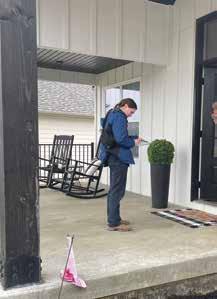
on Monday. In the meantime, Zane takes a call about a bicyclist who was chased and bitten by two dogs.
e two o cers discuss some follow-up that needs to happen from yesterday’s cases, and Emily takes the new call and goes to investigate but comes up empty-handed aside from a Ring doorbell conversation with someone who says they are not the owner.
ere are a couple of options when it comes to a dog or cat that has bitten someone, but in most cases the animal is impounded for ten days, although proof of rabies vaccination can make a di erence in the length of impoundment. e owner of a dog that has a previous history of biting can be issued an aggressive dog warning, which could result in the owner having to purchase a $350 permit per year. Also, anytime the dog leaves the house, it must be muzzled and on a leash no more than four feet in length.
“People need to be ready for the commitment of ownership and understand what is needed, including what rules have been established where you live,” Zane o ers quietly at the animal control o ce as he relays one of his job’s biggest challenges.
Emily agrees but also adds, “Please spay and neuter your pets and get them microchipped.” Both agree that socialization is vital to an animal’s well-being and making sure that they are vaccinated.
Animal Control has seven budgeted positions, but only ve are currently lled. e regular o ce hours are 7:30 a.m. to 5:30 p.m., seven days a week, except on all observed city of Columbia holidays. However, an animal control o cer is on-call after hours and on holidays for the following emergencies only: wildlife inside the living areas of a residence (not outside or in a garage), large animals running loose on a major roadway, sick or badly injured animals, vicious dogs that are currently running loose, and animal bites.
As our day winds up, Emily still has another hour to be in the o ce and there are still two more voicemails that need to be returned. Zane is on the phone, touching base with someone who is missing their dog. Emily and Zane nish their paperwork from the day and get caught up on upcoming court cases.
e day continues much in the same way it started.


Columbia-area ornithophiles flock together to celebrate our nesting neighbors.
BY MARCUS WILKINSBeneath the verdant canopy that shelters Kiwanis Park on College Park Drive, a group of binoculared birders dot a trail muddied by an unusually wet mid-Missouri May. Necks craned skyward, they listen and look, trading observations in hushed tones that belie their enthusiasm.
Some are newbies looking to explore a potential new hobby — and perhaps test drive a freshly downloaded app on their smartphone. Others are clearly experts, out tted with weathered gear and good-naturedly debating if they just heard a vireo of the red-eyed or Philadelphia variety.
“ is is Shazam for birds,” says Lottie Bushmann, president of the Columbia Audubon Society (CAS). She is assisting Kadie Crivello, a relatively new birder, who has deployed Merlin SoundID on her phone. “She identi ed it, named it — an American crow — and then veri ed it. It’s very satisfying.”
Today’s excursion is co-sponsored by CAS and aimed at identifying and counting birds who call this habitat home. e group is partnering with the Missouri Conservation Corps which in three years has removed scores of invasive honeysuckle plants and replaced them with regionally native ora. is year’s count has climbed slightly from 27 to 29 in the span of a year — a good sign.
“Native plants o er a greater variety of food,” says Stephen Bybee, project director for the Missouri Conservation Corps. “ ey play a bigger role in hosting insects that birds can eat, whereas honeysuckle just isn’t that kind of a plant.”
On that topic, several birders are gleefully trading their favorite food-themed mnemonic bird phrases. e Acadian ycatcher proclaims “pizza, pizza, pizza!” the Rufous-sided towee urges “drink your

teeea!” and the olive-sided ycatcher invites rapid revelry — “quick, three beers!”
For a hobby some outsiders assume to be mostly solitary, the camaraderie is remarkably palpable. Just visit the CAS Facebook page, which features an endless scrollable gallery of feathery photos and plenty of bird-nerd banter. And just like the partnership with the Missouri Conservation Corps, the Earth-conscious birding community nds itself in league with other green groups throughout the Show-Me State, including the Missouri Department of Conservation, Missouri River Bird Observatory, Missouri River Relief, and the University of Missouri’s Raptor Rehab Project, to name a few.
“For most of us, birding is a sweet mix of solitude and community,” says Edge Wade, president of the Missouri Birding Society. “One week, I might not bird with anybody else. e next I might go out with three
OPENING PAGE
Swainson’s Thrush
Photo by Lottie Bushmann
ABOVE
Columbia Audubon Society's Kiwanis Park: Birding Without Bush Honeysuckle. Wednesday, May 8, 2024.
Photo by Stephen Bybee
OPPOSITE PAGE
Left: Carolina Wren
Right: Summer Tanager


di erent groups. And even when you’re out on your own, it’s nice to have a group with which to share that joy and say, ‘I found a hooded warbler this morning,’ then tell everybody where it is and give them a chance to see it.”
Cheryl Rosenfeld migrated in 1995 to the University of Missouri where she is a professor of biomedical science in the College of Veterinary Medicine. When she’s not busy researching endocrine disrupting chemicals or lecturing to her pharmacology and microanatomy classes, she travels the U.S. and world looking for feathered friends.
“My ‘spark bird’ growing up in Skokie, Illinois, was actually an American robin,” says Rosenfeld, referring to the inspirational species that rst captures a birder’s imagination. “Outside my bedroom window we had a little nest every year and I was just so fascinated by it. It led me to nature and biology and then eventually my academic path to becoming an animal doctor.”
Like many modern birders, Rosenfeld relies heavily on smartphone apps to help identify, research, locate and catalog birds. (Her current international species count is 1,647.) She pulls up e-bird, the Cornell University birding app, to showcase some of her latest nds: a greater prairie chicken in Colorado, a black-and-white warbler in Columbia — and Colombia.

“ ere’s a connection between the South American country and our town because many of our spring birds reside there in the winter, and the country has become a more popular birding destination lately because it has become safer,” Rosenfeld said. “We have so many great spots here in Boone County, too. Rock Bridge State Park, 3M Flat Branch-Hinkson Creek Wetlands, Finger Lakes, Eagle Blu s. Just yesterday we had American avocets, black-necked stilts, and little-blue herons. For me it’s a hobby, but it’s also a way to focus.”

Rosenfeld isn’t alone. Most birding enthusiasts list the meditative and spiritual bene ts of immersing themselves in the wilderness — even if it’s within city limits — and simply observing.
Edge Wade’s spark bird — the rubycrowned kinglet — ew into her life while recovering from a surgically repaired occluded artery in her leg. She and her late husband, Jerry (a former Columbia City Council member), went to Rock Bridge State Park with some friends in 1993.
“I thought the friends were for companionship but later I learned it was so Jerry had help if he needed to carry me out,” Wade says with a laugh. “I immediately misidenti ed the kinglets and didn’t nd out until they came back in September. But I still couldn’t do very much physically so I committed to learning two birds a day. I would test myself at the end of the week.”
Birding became a passion for Edge and Jerry, who began globetrotting and tallying species. In 1999, the pair ew to Attu Island, Alaska, where they camped in an abandoned Coast Guard building and notched 111 di erent bird types. Wade has also traveled to Central and South America, the Galapagos Islands and Antarctica.
“Did you know penguin poop is pink?” asks Wade. “It’s because of the krill and other seafood they eat. You’re sailing along and everything’s gray, and then there’s an ice oe covered in pink snow.”
Wade’s lists are meticulously subdivided: international, domestic, Boone County (which stands at 308 species). Any weekday hike with the CAS or the Missouri Birding Society might net her another bird.
Yet she insists it’s not the competition that appeals to her.
“For me keeping track of birds is fun, and it gives me an incentive to get out,” Wade says. “I’m competing with myself. How did I do last year? Can I do as well this year, or am I just sitting on my rear too much?”
For the amiable Lottie Bushmann, strolling, chatting, and birding is the spice of life. A former elementary school teacher, she began incorporating lessons about birds to ignite her rst graders’ imaginations. But it was her own mind that was set a ame and forever linked to these beautiful, numerous and impossibly varied creatures that surround us.
ABOVE
Black-Capped Chickadee
“You start out by eye,” says Bushmann.
“ e best way to learn how to bird is to sit by a creek or another favorite spot with your binoculars, plenty of snacks and a drink, maybe a journal, colored pencils and a bird guide and just watch what happens. at’s how I learned the yellow warbler. I just watched it for hours; I drew it, and I learned exactly what it looked like when it sang.”

Bushmann has made a name for herself locally as the host of CAS-sponsored First Friday 3M Wetland hikes. Created to help lter stormwater runo , the preserve is the result of 17 agency partners working together to restore the habitat just o the entrance of the Forum Nature Area.
“I consider it my neighborhood,” Bushmann says. “ ere are about 180 spe-

cies. It’s so rich and diverse. And while migration right now is really fun, June is especially fun because the birds that stay will be nesting.”
e crown jewel of Bushmann’s birding history is the Hog Island (Maine) Audubon Camp, a trip sponsored by CAS. So enamored was she with the eastern island’s beauty and birdlife that she returned six times as a camp volunteer. She has since formed lifelong friends — many of whom she vacations with on her perpetual quest to see more birds.
Back in Kiwanis Park, the ragtag posse of birders continues its way

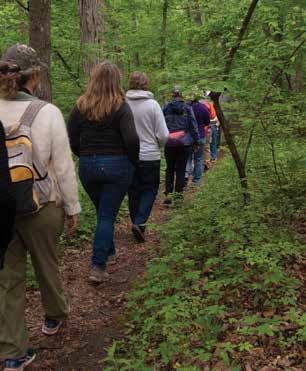
through the leafy corridors. Everyone holds a contented countenance, not beaming or giddy, but rather a look of peaceful curiosity as they swivel this way and that, peering through binoculars and pausing to identify a speci c solo amid the avian chorus.
For Bushmann and the other birders, it’s transcendental.
“I have a really strong internal clock, and I would say sometimes too strong,” Bushmann says. “When I bird, I lose it. It’s the only time in my life that I’ve ever lost that nagging feeling of ‘What time is it? Where should I be?’ It’s endlessly fascinating.”
Photos by Stephen Bybee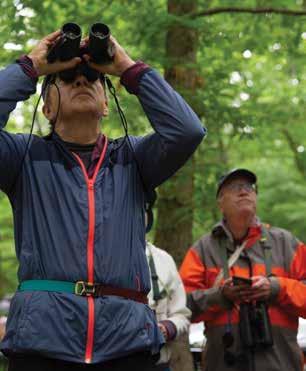







The
We




We
Few emotions rival the unbridled joy of bringing home a new pet;, from watching their adorable personalities blossom every day, to the funny things they do that just seem to somehow match the cute name you’ve given them. A new puppy, kitten, hamster, ferret, or similar four-legged new family member — maybe even a bearded dragon or an axolotl — can bring a new sense of purpose and companionship.
On the other hand, there can be emotional turmoil if you must face the di cult decision to rehome your pet due tonancial concerns, behavioral issues, moving somewhere that does not allow pets, or any number of circumstances where harsh realities overwhelm that joy.
Fortunately, Columbia has a bevy of pet rescues and shelters where pet parents faced with the rehoming question can nd understanding.
Each rescue o ers resources for pet owners to help them avoid rehoming their pet(s). For example, a woman took her dog to the Central Missouri Humane Society (CMHS), saying that her dog needed grooming, but she could not a ord that cost.
“Anything we can do to keep a pet with the owner, we do that,” said Michelle Casey, associate director of CHMS. Instead of taking the dog into the shelter, the sta asked the woman to wait, performed the needed grooming, and returned the pup to its owner. Casey said the owner was relieved and touched by that act of compassion.
CMHS is the only open admission shelter in Columbia, which means that it takes in any animal, no matter the breed, species, age, or temperament. Like other rescues, CMHS o ers behavioral training and is willing to work with owners to help them keep their pets. ere’s even a resource to help mitigate one of the biggest reasons for a person relinquishing their pet: ey can’t nd pet-friendly housing. e CMHS website o ers resources and tips for the issue.
CMHS also o ers the “Animal Safety Net Program,” which is designed for survivors of domestic abuse.
“We have found there are quite a few people who stay with their abusers because they don’t want to leave their pet behind,” Casey explained. CMHS takes survivors’ pets into a foster program. After the survivors are safe and established, they are reunited with the pet. And for those struggling to meet a pet’s needs due to nances, CMHS o ers a pet food bank that is accessible with online registration.
Another reason a pet owner might feel the need to rehome their pet is starting a family.
“We see that owners have a dog — get it early on as a couple — and once the couple starts having babies, things go awry,” said Karen Kammrich, owner of Midwest Australian Shepherd Rescue (MASR). She added, “ e Midwest is overrun with dogs.”
Kammrich explained that MASR alone gets four to six rehoming requests every day. She encourages potential pet parents to spend time learning about a breed’s speci c needs before getting a dog.
“ e bottom line is, I feel like I am emptying the ocean one teaspoon at a time. And it’s not going to end. Right now with rescues and shelters and pounds, we are all in a critical phase,” she added. She o ers some advice on safely rehoming a pet when that decision is being considered.
• Have the individual interested in adopting your pet sign paperwork . Arrange for it to go somewhere else if the pet doesn’t work out at that new home.
• Require veterinarian references; call the vet and ask if the pet owner keeps their pets up to date on vaccines and exams.
• Ask the new potential owners how they feel about taking on that speci c animal or breed.
“Make sure the gut feeling is there that these people are going to take care of your dog or feel right for your dog,” Kimmrich said.
As the 2024 Pet Sitter of the year for Pet Sitters International, Bobbi Wilson, owner of Peace Love Paws Pet Sitters and Pets Need People, has a passion for educating pet parents. Wilson’s website has a podcast and blog with topics ranging from how to safely transport your pet to preparing what to do with your pets if there are natural disasters.
For Wilson, it’s all about good pet care and education. Some important questions to consider before adopting an animal: Will you be able to provide training for your dog? Can you a ord their food and veterinary care? She also mentioned the situation where an older person gets a dog, puppy, or other pet that will likely outlive the owner. Considering such circumstances before bringing a new pet into a home can avoid the rehoming dilemma.
“[Fostering] is a hugely rewarding experience and I encourage you to give it a shot. I would venture to say that if you’re an animal person, you’re gonna love it.”
- GIULIA HALL , executive director of Columbia Second Chance
HUMANE SOCIETY
BOONE COUNTY ANIMAL CARE
UNCHAINED MELODIES DOG RESCUE
LIL’ PAWS, BIG HEARTS
MIDWEST AUSSIE RESCUE
Meanwhile, rescue groups say that the demand for foster homes for pets is at an all-time high. Columbia Second Chance, Boone County Animal Care, and CMHS are all in dire need for foster placements.
“It is a hugely rewarding experience and I encourage you to give it a shot. I would venture to say that if you’re an animal person, you’re gonna love it.” said Giulia Hall, executive director of Columbia Second Chance (CSC). Giulia noted that many people want to foster but are hesitant because they would want to keep every pet. at could be true, but every dog or cat is not perfect for your home, she said, adding that helping rehomed pets nd their perfect home is extremely rewarding.
If a pet owner needs to rehome a pet, Second Chance strongly encourages that the owner be the foster parent until a new home can be found. CSC provides everything the pet needs while it is in a foster home.
If someone who adopts from CSC is having some trouble with their pet’s behavior, the organization o ers a visit from a trainer to help the owner keep their animal. If someone relinquishes a pet to CSC, a training session is provided and sometimes the owners end up keeping their pets because there was a solution to their issue. CMC’s website o ers resources for lower cost veterinary care, training, a list of charities that provide medical nancial assistance for pets, and a list of housing that accept certain dog breeds.
Boone County Animal Care (BCAC) is a foster-based rescue focusing on emergency cat rescues, like saving cats from euthanizing shelters. BCAC does not accept owner surrenders, but it tries to o er solutions for people who are considering rehoming.
One reason an owner might want to relinquish their cat is due to behavioral issues.
Jennifer Romesburg, founder and president of BCAC, explained that cats communicate by peeing and defecating in places they shouldn’t because they are telling you there is a problem. ere could be a simple solution to behavioral issues in cats. Taking the cat to the vet to rule out a behavioral or medical is the rst step. e number of pet owners who do not spay or neuter their pets could be adding to the inux of animals in shelters.
“Almost every single reason for rehoming can all be xed by spaying and neutering your pets before six months of age,” Romesburg said, adding that spaying, neutering, and vaccinating reduces many health and disease risks.
And human disease — everyone remembers 2020 — is another factor for why rescues are so packed now.
“We are de nitely still seeing a surge in people rehoming pets since COVID-19, in addition to the state of the economy,” said Melody Whitworth, founding director of Unchained Melodies Dog Rescue. In an email, Whitworth said, “COVID dogs were not socialized or trained properly. Once things opened up, people went back to work, started traveling, and families are busier than ever.
e dogs su er from anxiety. ey are not properly exercised physically or mentally, and people are giving up on a dog that was there for them in the worst of times — and they should now be there for their pet.”
She explained that the number one reason for a dog to be banished to a chain or a pen is lack of training. Unchained Melodies o ers training and socializing classes to prevent dogs from entering a shelter.
Each local rescue organization echoes the advice that when you get a pet, have a plan for rehoming in case something happens to you as the owner.
“It is also very important to con rm that they have discussed this plan with the intended bene ciary,” said Klaudia Rejmer, founder of Lil Paws, Big Hearts Chihuahua Rescue in an email. She also encouraged people who are in a transitional period of their life such as graduating, thinking about having kids, moving, or facing a di erent challenge to wait to get a pet, as the situation could lead to rehoming.
“Almost every single reason for rehoming can all be fixed by spaying and neutering your pets before six months of age,”
- JENNIFER ROMESBURG, founder and president of BCAC



Not surprisingly, it’s sometimes our fur babies (and feather and scale babies) not-so-perfect attributes that make them completely and utterly adorable. Here’s just a small sample, you can check out more online.

My boy BERT is a Go n Cockatoo, He is my buddy. He’s so much fun, loves to play with his stu ed animals. Came into my life when I needed him, and he needed me. He enjoys going for car rides where I take him shopping and to visit friends and family. I love him most for being the character he is.
— TRACY KING

ARCHER is the best pup because he is always up for an adventure, and he just loves everyone he meets. From oat trips to snuggles in bed, Archer is the best friend anyone could ask for! — CHERYL KEEVEN DIAZ

is is MOWGLI , my rescue from CMHS! He’s slowly started letting his chaos show after being surrendered. I love seeing him come out of his shell and become my favorite buddy to go on walks with.
— ASHLEY LASITER
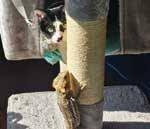
LEO the bearded dragon and OREO the cat are both very precious to our family and have become good friends with each other!
—JESSICA BALDWIN


BILL , my 16 year old Belgian draft horse. He’s a champion puller, and a xture in e District the last two years during the holidays. He’s got an engaging personality, but keeps the intensity he brings when he competes close to the surface at all times. — RYAN SMITH

is handsome fellow, TWEEKY, loves car rides and snuggles. Says Peekaboo and his name. — BRITTANY HALE-DODSON

is is BELLA . My silkie chicken. She is so sweet and provides me breakfast on the daily! — ANGELA HUNTINGTON
WALLY boy is just too good not to share. He’s the sweetest, smartest, snuggliest boy this rst-time dog owner could have hoped for… and he looks great in a bomber jacket.
— KRISTEN WALKER

OSIRIS is the crosseyed space cat that drools when he is happy, getting food, or being pet. — BLAKE WILLOUGHBY

Deciding when and how to bring family members together to share your vision for how your wealth will be distributed is a very personal, and often difficult, decision. Consider the following suggestions for when and how to bring the next generation of your family together to learn about your estate plan and long-term goals for your wealth.
Every family is unique so one type of family meeting may fit better than another. Consider involving a wealth management professional who can help identify which approach is right for your family. Or ask a member of your wealth management team to serve as an independent third party to mediate the conversation.
Family Councils: Some families create a family council consisting of family members from each generation.
Family Foundations: Others view family meetings as a time to involve loved ones in their family’s private foundation. For many families, it is

important for younger generations to get involved earlier rather than later in life.
Family Business Meetings: For family members who are not working for the family business, attending a family business meeting is a way to involve them in the business in a way that will not impact daily operations.
Next-Generation Education:
Sometimes, next-generation meetings can be more focused on wealth preservation and financial education.
Finally, it is common to arrange family meetings to bring loved ones together. Creating a space in which each generation feels able to communicate how they are feeling and that the rest of the family is listening to them sets a positive tone for these conversations.
Here are a few ideas to consider:
• Sometimes it can be beneficial to separate into groups and let family
members who are part of the next generation meet as one group.
• You might choose to invite an independent third party (outside the family) to participate in these meetings and help facilitate conversation.
• Plan a meeting at a location away from where family members live. This allows for more family time outside of the meeting if everyone is staying at the same location.
Commerce Trust offers a team-based holistic approach to estate planning that includes facilitating various types of family gatherings. Allowing your Commerce Trust wealth management team to act as a third party in family meetings could allow for a balanced and objective approach to difficult subjects. Contact Commerce Trust today to learn more about how we can help you navigate family estate planning conversations, so all family members are appropriately included.